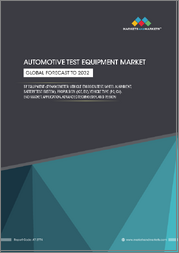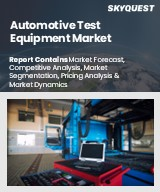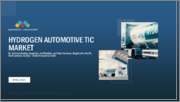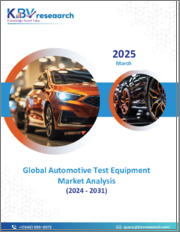
|
시장보고서
상품코드
1585380
세계의 자동차 테스트 장비 시장 : 제품별, 기술별, 용도별, 차량별, 최종 사용자별-예측(2025-2030년)Automotive Test Equipment Market by Product (Chassis Dynamometer, Engine Dynamometer, Vehicle Emission Test System), Technology (ADAS Testing, Data Logger, ECU Testing), Application, Vehicle, End User - Global Forecast 2025-2030 |
||||||
세계 자동차 테스트 장비 시장의 2023년 시장 규모는 24억 6,000만 달러로 평가되었고, 2024년에는 25억 9,000만 달러로 추정되며, CAGR 5.55%로 성장할 전망이고, 2030년에는 35억 9,000만 달러에 도달할 것으로 예상됩니다.
세계의 자동차 테스트 장비 시장 범위와 정의에는 자동차 품질, 기능성, 안전성을 검사, 테스트 및 유지하는 데 사용되는 기기 및 시스템이 포함됩니다. 여기에는 엔진 진단, 배터리 시험, 배기 가스 시험, 다양한 전자적 및 기계적 평가를 위한 도구가 포함됩니다. 이러한 기기의 필요성은 엄격한 안전 규제, 높은 차량 성능의 요구, 배출 가스 감축의 필요성으로부터 생기며, 제조업체가 강화된 시험 솔루션을 채용하는 원동력이 되고 있습니다. 그 용도는 연구개발, 자동차 생산라인, 서비스 및 유지보수 등 다양합니다. 주요 최종 사용자는 자동차 제조 업체, 서비스 센터, 규제 기관 등입니다.
| 주요 시장 통계 | |
|---|---|
| 기준년(2023년) | 24억 6,000만 달러 |
| 예측년(2024년) | 25억 9,000만 달러 |
| 예측년(2030년) | 35억 9,000만 달러 |
| CAGR(%) | 5.55% |
시장 성장은 인공지능과 사물인터넷 등의 선진기술의 통합에 의해 보다 정밀한 진단이나 실시간 모니터링이 용이해진 것에 크게 영향을 받고 있습니다. 또, 전동화나 자율 주행차에 대한 동향의 고조도 특수한 시험장치에 대한 수요를 뒷받침하고 있습니다. 휴대용 AI 구동 진단 도구와 새로운 자동차 기술을 지원하는 범용적이고 확장 가능한 테스트 솔루션을 개발하는 데는 비즈니스 기회가 있습니다. 기업은 연결성, 사용자 경험, 새로운 차량 기술에 대한 적응성에 초점을 맞춘 연구와 혁신에 투자함으로써 이들을 활용할 수 있습니다.
그러나 시장 성장의 과제는 높은 설비 비용 및 새로운 테스트 솔루션을 기존 시스템에 통합하는 것에 대한 복잡성입니다. 게다가 이 시장에는 숙련된 인재가 필요하지만, 고도의 시험 장치를 취급할 수 있는 유자격의 기술자가 부족한 것이 장벽이 되고 있습니다. 이러한 문제를 극복하기 위해 업계는 사용자 친화적인 인터페이스 개발, 혁신적인 설계로 장비 비용 절감, 종합적인 교육 프로그램 제공에 주력할 수 있습니다.
기술 혁신이 기대되는 분야로는 소프트웨어 주도의 시험 솔루션, 진단을 강화하기 위한 증강현실(AR)의 도입, 지속 가능한 실천에 따른 친환경 시험 방법 등을 들 수 있습니다. 전반적으로, 시장 상황은 성장 기회가 많은 역동적인 시장이며, 복잡한 상황을 효과적으로 극복하기 위해서는 전략적 적응과 기술적 진보가 필요합니다.
시장 역학 : 급속히 진화하는 세계의 자동차 테스트 장비 시장의 주요 시장 인사이트 공개
세계의 자동차 테스트 장비 시장은 수요 및 공급의 역동적인 상호작용에 의해 변모를 이루고 있습니다. 이러한 시장 역학의 진화를 이해함으로써 기업은 충분한 정보를 바탕으로 투자결정, 전략적 결정 정밀화, 새로운 비즈니스 기회 획득에 대비할 수 있습니다. 이러한 동향을 종합적으로 파악함으로써 기업은 정치적, 지리적, 기술적, 사회적, 경제적 영역에 걸친 다양한 리스크를 경감할 수 있을 뿐만 아니라, 소비자 행동과 그것이 제조 비용 또는 구매 동향에 미치는 영향을보다 명확하게 이해할 수 있습니다.
- 시장 성장 촉진요인
- 전기자동차와 자율주행차의 생산 대수 증가
- 자동차에 의한 환경 영향을 저감하기 위한 엄격한 정부 규제
- 자동차의 전자 부품 통합화의 진전
- 시장 성장 억제요인
- 테스트 장비 비용과 활동 불균형
- 시장 기회
- 자동차 분야에서의 온보드 진단 툴 수요
- 자동차의 실시간 데이터 분석 및 시뮬레이션 테스트 증가
- 시장의 과제
- 훈련된 전문가의 부족과 첨단 기기의 부족
Porter's Five Forces : 세계의 자동차 테스트 장비 시장을 탐색하는 전략 도구
Porter's Five Forces 프레임 워크는 시장 상황경쟁 구도를 이해하는 중요한 도구입니다. Porter's Five Forces 프레임 워크는 기업의 경쟁력을 평가하고 전략적 기회를 탐구하는 명확한 기술을 제공합니다. 이 프레임 워크는 기업이 시장 내 세력도를 평가하고 신규 사업의 수익성을 결정하는 데 도움이 됩니다. 이러한 인사이트를 통해 기업은 자사의 강점을 활용하고, 약점을 해결하고, 잠재적인 과제를 피할 수 있으며, 보다 강인한 시장에서의 포지셔닝을 보장할 수 있습니다.
PESTLE 분석 : 세계의 자동차 테스트 장비 시장에서 외부로부터의 영향 파악
외부 거시 환경 요인은 세계의 자동차 테스트 장비 시장의 성과 역학을 형성하는데 매우 중요한 역할을 합니다. 정치적, 경제적, 사회적, 기술적, 법적, 환경적 요인 분석은 이러한 영향을 탐색하는 데 필요한 정보를 제공합니다. PESTLE 요인을 조사함으로써 기업은 잠재적인 위험과 기회를 더 잘 이해할 수 있습니다. 이 분석을 통해 기업은 규제, 소비자 선호, 경제 동향의 변화를 예측하고 앞으로 예상되는 적극적인 의사 결정을 할 준비를 할 수 있습니다.
시장 점유율 분석 : 세계의 자동차 테스트 장비 시장에서 경쟁 구도 파악
세계의 자동차 테스트 장비 시장에 대한 상세한 시장 점유율 분석을 통해 공급업체의 성과를 종합적으로 평가할 수 있습니다. 기업은 수익, 고객 기반, 성장률 등 주요 지표를 비교하여 경쟁 포지셔닝을 밝힐 수 있습니다. 이 분석을 통해 시장 집중, 단편화, 통합 동향을 밝혀내고 벤더들은 경쟁이 치열해지는 가운데 자사의 지위를 높이는 전략적 의사 결정을 내리는 데 필요한 지식을 얻을 수 있습니다.
FPNV 포지셔닝 매트릭스 : 세계의 자동차 테스트 장비 시장에서 공급업체의 성능 평가
FPNV 포지셔닝 매트릭스는 세계의 자동차 테스트 장비 시장에서 공급업체를 평가하는 중요한 도구입니다. 이 행렬을 통해 비즈니스 조직은 공급업체의 비즈니스 전략과 제품 만족도를 기준으로 평가하여 목표에 맞는 충분한 정보를 바탕으로 의사 결정을 내릴 수 있습니다. 네 가지 사분면을 통해 공급업체를 명확하고 정확하게 세분화하여 전략 목표에 가장 적합한 파트너 및 솔루션을 파악할 수 있습니다.
전략 분석 및 추천 : 세계의 자동차 테스트 장비 시장에서 성공을 위한 길을 그리기
세계의 자동차 테스트 장비 시장의 전략 분석은 세계 시장에서의 프레즌스 강화를 목표로 하는 기업에 필수적입니다. 주요 자원, 능력 및 성과 지표를 검토함으로써 기업은 성장 기회를 파악하고 개선을 위해 노력할 수 있습니다. 이러한 접근 방식을 통해 경쟁 구도에서 과제를 극복하고 새로운 비즈니스 기회를 활용하여 장기적인 성공을 거둘 수 있는 체제를 구축할 수 있습니다.
이 보고서는 주요 관심 분야를 포괄하는 시장의 종합적인 분석을 제공합니다.
1. 시장 침투 : 현재 시장 환경의 상세한 검토, 주요 기업의 광범위한 데이터, 시장 도달범위 및 전반적인 영향력을 평가합니다.
2. 시장 개척도 : 신흥 시장의 성장 기회를 파악하고 기존 분야의 확장 가능성을 평가하며 미래 성장을 위한 전략적 로드맵을 제공합니다.
3. 시장 다양화 : 최근 제품 시장, 미개척 지역, 업계의 주요 진보, 시장을 형성하는 전략적 투자를 분석합니다.
4. 경쟁 평가 및 정보 : 경쟁 구도를 철저히 분석하여 시장 점유율, 사업 전략, 제품 포트폴리오, 인증, 규제 당국 승인, 특허 동향, 주요 기업의 기술 진보 등을 검증합니다.
5. 제품 개발 및 혁신 : 미래 시장 성장을 가속할 것으로 예상되는 최첨단 기술, 연구개발 활동, 제품 혁신을 강조합니다.
또한 이해관계자가 충분한 정보를 얻고 의사결정을 할 수 있도록 중요한 질문에 대답하고 있습니다.
1. 현재 시장 규모 및 향후 성장 예측은?
2. 최고의 투자 기회를 제공하는 제품, 부문 및 지역은 어디입니까?
3. 시장을 형성하는 주요 기술 동향 및 규제의 영향은?
4. 주요 벤더의 시장 점유율 및 경쟁 포지션은?
5. 벤더 시장 진입 및 철수 전략의 원동력이 되는 수익원과 전략적 기회는 무엇인가?
목차
제1장 서문
제2장 조사 방법
제3장 주요 요약
제4장 시장 개요
제5장 시장 인사이트
- 시장 역학
- 성장 촉진요인
- 전기차와 자율주행차의 생산 증가
- 자동차의 환경에 대한 영향을 줄이기 위한 엄격한 정부 규제
- 차량에서의 전자부품의 통합 확대
- 억제요인
- 테스트 장비의 비용과 활동의 불균형
- 기회
- 자동차 분야에서의 차량 탑재 진단 툴 수요
- 차량의 실시간 데이터 분석 및 시뮬레이션 테스트 증가
- 과제
- 훈련을 받은 전문가의 부족과 고도의 설비의 부족
- 성장 촉진요인
- 시장 세분화 분석
- Porter's Five Forces 분석
- PESTEL 분석
- 정치적
- 경제
- 사교
- 기술적
- 법률상
- 환경
제6장 세계의 자동차 테스트 장비 시장 : 제품별
- 섀시 다이나모미터
- 엔진 다이나모미터
- 차량 배출 가스 테스트 시스템
- 휠 얼라인먼트 테스터
제7장 세계의 자동차 테스트 장비 시장 : 기술별
- ADAS 테스트
- 데이터 로거
- ECU 테스트
- EV 테스트
- 시뮬레이션 테스트
제8장 세계의 자동차 테스트 장비 시장 : 용도별
- 모바일 또는 태블릿 기반 기기
- PC 또는 노트북 기반 기기
제9장 세계의 자동차 테스트 장비 시장 : 차량별
- 상용차
- 대형 상용차
- 소형 상용차
- 승용차
제10장 세계의 자동차 테스트 장비 시장 : 최종 사용자별
- 인증 서비스 센터
- OEM 조립 공장
- OEM R&D 또는 기술 센터
제11장 아메리카의 자동차 테스트 장비 시장
- 아르헨티나
- 브라질
- 캐나다
- 멕시코
- 미국
제12장 아시아태평양의 자동차 테스트 장비 시장
- 호주
- 중국
- 인도
- 인도네시아
- 일본
- 말레이시아
- 필리핀
- 싱가포르
- 한국
- 대만
- 태국
- 베트남
제13장 유럽, 중동 및 아프리카의 자동차 테스트 장비 시장
- 덴마크
- 이집트
- 핀란드
- 프랑스
- 독일
- 이스라엘
- 이탈리아
- 네덜란드
- 나이지리아
- 노르웨이
- 폴란드
- 카타르
- 러시아
- 사우디아라비아
- 남아프리카
- 스페인
- 스웨덴
- 스위스
- 터키
- 아랍에미리트(UAE)
- 영국
제14장 경쟁 구도
- 시장 점유율 분석(2023년)
- FPNV 포지셔닝 매트릭스(2023년)
- 경쟁 시나리오 분석
- 전략 분석 및 제안
기업 목록
- ABB Ltd.
- ACTIA Group
- Advantest Corporation
- Alfamation SpA
- Anritsu Corporation
- Continental AG
- ETAS Group
- Fluke Corporation
- Honeywell International Inc.
- Horiba, Ltd.
- Moog, Inc.
- National Instruments Corporation
- PCE Deutschland GmbH
- ROBERT BOSCH GMBH
- Rohde & Schwarz GmbH & Co. KG
- SGS SA
- Siemens AG
- Snap-on Incorporated
- Softing AG
- SPEA SpA
- TASI Group
- Teradyne, Inc.
- Vector Informatik GmbH
The Automotive Test Equipment Market was valued at USD 2.46 billion in 2023, expected to reach USD 2.59 billion in 2024, and is projected to grow at a CAGR of 5.55%, to USD 3.59 billion by 2030.
The scope and definition of the automotive test equipment market encompass devices and systems used for inspecting, testing, and maintaining vehicles' quality, functionality, and safety. This includes tools for evaluating engine diagnostics, battery testing, emission tests, and various electronic and mechanical assessments. The necessity for such equipment arises from stringent safety regulations, the demand for high vehicle performance, and the need to reduce emissions, driving manufacturers to adopt enhanced testing solutions. Applications span a range of areas including research and development, vehicle production lines, and service and maintenance settings. Major end-users include automotive manufacturers, service centers, and regulatory agencies.
| KEY MARKET STATISTICS | |
|---|---|
| Base Year [2023] | USD 2.46 billion |
| Estimated Year [2024] | USD 2.59 billion |
| Forecast Year [2030] | USD 3.59 billion |
| CAGR (%) | 5.55% |
Market growth is heavily influenced by the integration of advanced technologies such as Artificial Intelligence and the Internet of Things, facilitating more precise diagnostics and real-time monitoring. The increasing trend toward electrification and autonomous vehicles also propels demand for specialized test equipment. Opportunities lie in the development of portable and AI-driven diagnostic tools as well as versatile and scalable testing solutions to accommodate new vehicle technologies. Companies can capitalize on these by investing in research and innovation focused on connectivity, user experience, and adaptability to emerging vehicle technologies.
However, market growth is challenged by high equipment costs and the complexity of integrating new testing solutions into existing systems. Additionally, the market requires skilled personnel, which poses a barrier due to the shortage of qualified technicians able to handle advanced testing equipment. To overcome these challenges, the industry could focus on developing user-friendly interfaces, reducing equipment costs through innovative design, and offering comprehensive training programs.
Areas poised for innovation include software-driven test solutions, the incorporation of augmented reality for enhanced diagnostics, and eco-friendly test methods that align with sustainable practices. Overall, the automotive test equipment market presents a dynamic landscape with extensive opportunities for growth, requiring strategic adaptation and technological advancement to navigate its complexities effectively.
Market Dynamics: Unveiling Key Market Insights in the Rapidly Evolving Automotive Test Equipment Market
The Automotive Test Equipment Market is undergoing transformative changes driven by a dynamic interplay of supply and demand factors. Understanding these evolving market dynamics prepares business organizations to make informed investment decisions, refine strategic decisions, and seize new opportunities. By gaining a comprehensive view of these trends, business organizations can mitigate various risks across political, geographic, technical, social, and economic domains while also gaining a clearer understanding of consumer behavior and its impact on manufacturing costs and purchasing trends.
- Market Drivers
- Rising production of electric and autonomous vehicles
- Strict government regulations to reduce environmental impact from automobile
- Growing integration of electronic parts in the vehicles
- Market Restraints
- Imbalance between cost and activity of test equipment
- Market Opportunities
- Demand for on-board diagnostic tools in automotive sector
- Increase in analysis of real-time data and simulation testing in vehicles
- Market Challenges
- Shortage of trained professional and lack of advance equipment
Porter's Five Forces: A Strategic Tool for Navigating the Automotive Test Equipment Market
Porter's five forces framework is a critical tool for understanding the competitive landscape of the Automotive Test Equipment Market. It offers business organizations with a clear methodology for evaluating their competitive positioning and exploring strategic opportunities. This framework helps businesses assess the power dynamics within the market and determine the profitability of new ventures. With these insights, business organizations can leverage their strengths, address weaknesses, and avoid potential challenges, ensuring a more resilient market positioning.
PESTLE Analysis: Navigating External Influences in the Automotive Test Equipment Market
External macro-environmental factors play a pivotal role in shaping the performance dynamics of the Automotive Test Equipment Market. Political, Economic, Social, Technological, Legal, and Environmental factors analysis provides the necessary information to navigate these influences. By examining PESTLE factors, businesses can better understand potential risks and opportunities. This analysis enables business organizations to anticipate changes in regulations, consumer preferences, and economic trends, ensuring they are prepared to make proactive, forward-thinking decisions.
Market Share Analysis: Understanding the Competitive Landscape in the Automotive Test Equipment Market
A detailed market share analysis in the Automotive Test Equipment Market provides a comprehensive assessment of vendors' performance. Companies can identify their competitive positioning by comparing key metrics, including revenue, customer base, and growth rates. This analysis highlights market concentration, fragmentation, and trends in consolidation, offering vendors the insights required to make strategic decisions that enhance their position in an increasingly competitive landscape.
FPNV Positioning Matrix: Evaluating Vendors' Performance in the Automotive Test Equipment Market
The Forefront, Pathfinder, Niche, Vital (FPNV) Positioning Matrix is a critical tool for evaluating vendors within the Automotive Test Equipment Market. This matrix enables business organizations to make well-informed decisions that align with their goals by assessing vendors based on their business strategy and product satisfaction. The four quadrants provide a clear and precise segmentation of vendors, helping users identify the right partners and solutions that best fit their strategic objectives.
Strategy Analysis & Recommendation: Charting a Path to Success in the Automotive Test Equipment Market
A strategic analysis of the Automotive Test Equipment Market is essential for businesses looking to strengthen their global market presence. By reviewing key resources, capabilities, and performance indicators, business organizations can identify growth opportunities and work toward improvement. This approach helps businesses navigate challenges in the competitive landscape and ensures they are well-positioned to capitalize on newer opportunities and drive long-term success.
Key Company Profiles
The report delves into recent significant developments in the Automotive Test Equipment Market, highlighting leading vendors and their innovative profiles. These include ABB Ltd., ACTIA Group, Advantest Corporation, Alfamation S.p.A, Anritsu Corporation, Continental AG, ETAS Group, Fluke Corporation, Honeywell International Inc., Horiba, Ltd., Moog, Inc., National Instruments Corporation, PCE Deutschland GmbH, ROBERT BOSCH GMBH, Rohde & Schwarz GmbH & Co. KG, SGS S.A., Siemens AG, Snap-on Incorporated, Softing AG, SPEA S.p.A., TASI Group, Teradyne, Inc., and Vector Informatik GmbH.
Market Segmentation & Coverage
This research report categorizes the Automotive Test Equipment Market to forecast the revenues and analyze trends in each of the following sub-markets:
- Based on Product, market is studied across Chassis Dynamometer, Engine Dynamometer, Vehicle Emission Test System, and Wheel Alignment Tester.
- Based on Technology, market is studied across ADAS Testing, Data Logger, ECU Testing, EV Testing, and Simulation Testing.
- Based on Application, market is studied across Mobile or Tablet Based Equipment and PC or Laptop Based Equipment.
- Based on Vehicle, market is studied across Commercial Vehicle and Passenger Car. The Commercial Vehicle is further studied across Heavy Commercial Vehicle and Light Commercial Vehicle.
- Based on End User, market is studied across Authorized Service Center, OEM Assembly Plant, and OEM R&D or Technical Center.
- Based on Region, market is studied across Americas, Asia-Pacific, and Europe, Middle East & Africa. The Americas is further studied across Argentina, Brazil, Canada, Mexico, and United States. The United States is further studied across California, Florida, Illinois, New York, Ohio, Pennsylvania, and Texas. The Asia-Pacific is further studied across Australia, China, India, Indonesia, Japan, Malaysia, Philippines, Singapore, South Korea, Taiwan, Thailand, and Vietnam. The Europe, Middle East & Africa is further studied across Denmark, Egypt, Finland, France, Germany, Israel, Italy, Netherlands, Nigeria, Norway, Poland, Qatar, Russia, Saudi Arabia, South Africa, Spain, Sweden, Switzerland, Turkey, United Arab Emirates, and United Kingdom.
The report offers a comprehensive analysis of the market, covering key focus areas:
1. Market Penetration: A detailed review of the current market environment, including extensive data from top industry players, evaluating their market reach and overall influence.
2. Market Development: Identifies growth opportunities in emerging markets and assesses expansion potential in established sectors, providing a strategic roadmap for future growth.
3. Market Diversification: Analyzes recent product launches, untapped geographic regions, major industry advancements, and strategic investments reshaping the market.
4. Competitive Assessment & Intelligence: Provides a thorough analysis of the competitive landscape, examining market share, business strategies, product portfolios, certifications, regulatory approvals, patent trends, and technological advancements of key players.
5. Product Development & Innovation: Highlights cutting-edge technologies, R&D activities, and product innovations expected to drive future market growth.
The report also answers critical questions to aid stakeholders in making informed decisions:
1. What is the current market size, and what is the forecasted growth?
2. Which products, segments, and regions offer the best investment opportunities?
3. What are the key technology trends and regulatory influences shaping the market?
4. How do leading vendors rank in terms of market share and competitive positioning?
5. What revenue sources and strategic opportunities drive vendors' market entry or exit strategies?
Table of Contents
1. Preface
- 1.1. Objectives of the Study
- 1.2. Market Segmentation & Coverage
- 1.3. Years Considered for the Study
- 1.4. Currency & Pricing
- 1.5. Language
- 1.6. Stakeholders
2. Research Methodology
- 2.1. Define: Research Objective
- 2.2. Determine: Research Design
- 2.3. Prepare: Research Instrument
- 2.4. Collect: Data Source
- 2.5. Analyze: Data Interpretation
- 2.6. Formulate: Data Verification
- 2.7. Publish: Research Report
- 2.8. Repeat: Report Update
3. Executive Summary
4. Market Overview
5. Market Insights
- 5.1. Market Dynamics
- 5.1.1. Drivers
- 5.1.1.1. Rising production of electric and autonomous vehicles
- 5.1.1.2. Strict government regulations to reduce environmental impact from automobile
- 5.1.1.3. Growing integration of electronic parts in the vehicles
- 5.1.2. Restraints
- 5.1.2.1. Imbalance between cost and activity of test equipment
- 5.1.3. Opportunities
- 5.1.3.1. Demand for on-board diagnostic tools in automotive sector
- 5.1.3.2. Increase in analysis of real-time data and simulation testing in vehicles
- 5.1.4. Challenges
- 5.1.4.1. Shortage of trained professional and lack of advance equipment
- 5.1.1. Drivers
- 5.2. Market Segmentation Analysis
- 5.3. Porter's Five Forces Analysis
- 5.3.1. Threat of New Entrants
- 5.3.2. Threat of Substitutes
- 5.3.3. Bargaining Power of Customers
- 5.3.4. Bargaining Power of Suppliers
- 5.3.5. Industry Rivalry
- 5.4. PESTLE Analysis
- 5.4.1. Political
- 5.4.2. Economic
- 5.4.3. Social
- 5.4.4. Technological
- 5.4.5. Legal
- 5.4.6. Environmental
6. Automotive Test Equipment Market, by Product
- 6.1. Introduction
- 6.2. Chassis Dynamometer
- 6.3. Engine Dynamometer
- 6.4. Vehicle Emission Test System
- 6.5. Wheel Alignment Tester
7. Automotive Test Equipment Market, by Technology
- 7.1. Introduction
- 7.2. ADAS Testing
- 7.3. Data Logger
- 7.4. ECU Testing
- 7.5. EV Testing
- 7.6. Simulation Testing
8. Automotive Test Equipment Market, by Application
- 8.1. Introduction
- 8.2. Mobile or Tablet Based Equipment
- 8.3. PC or Laptop Based Equipment
9. Automotive Test Equipment Market, by Vehicle
- 9.1. Introduction
- 9.2. Commercial Vehicle
- 9.2.1. Heavy Commercial Vehicle
- 9.2.2. Light Commercial Vehicle
- 9.3. Passenger Car
10. Automotive Test Equipment Market, by End User
- 10.1. Introduction
- 10.2. Authorized Service Center
- 10.3. OEM Assembly Plant
- 10.4. OEM R&D or Technical Center
11. Americas Automotive Test Equipment Market
- 11.1. Introduction
- 11.2. Argentina
- 11.3. Brazil
- 11.4. Canada
- 11.5. Mexico
- 11.6. United States
12. Asia-Pacific Automotive Test Equipment Market
- 12.1. Introduction
- 12.2. Australia
- 12.3. China
- 12.4. India
- 12.5. Indonesia
- 12.6. Japan
- 12.7. Malaysia
- 12.8. Philippines
- 12.9. Singapore
- 12.10. South Korea
- 12.11. Taiwan
- 12.12. Thailand
- 12.13. Vietnam
13. Europe, Middle East & Africa Automotive Test Equipment Market
- 13.1. Introduction
- 13.2. Denmark
- 13.3. Egypt
- 13.4. Finland
- 13.5. France
- 13.6. Germany
- 13.7. Israel
- 13.8. Italy
- 13.9. Netherlands
- 13.10. Nigeria
- 13.11. Norway
- 13.12. Poland
- 13.13. Qatar
- 13.14. Russia
- 13.15. Saudi Arabia
- 13.16. South Africa
- 13.17. Spain
- 13.18. Sweden
- 13.19. Switzerland
- 13.20. Turkey
- 13.21. United Arab Emirates
- 13.22. United Kingdom
14. Competitive Landscape
- 14.1. Market Share Analysis, 2023
- 14.2. FPNV Positioning Matrix, 2023
- 14.3. Competitive Scenario Analysis
- 14.4. Strategy Analysis & Recommendation
Companies Mentioned
- 1. ABB Ltd.
- 2. ACTIA Group
- 3. Advantest Corporation
- 4. Alfamation S.p.A
- 5. Anritsu Corporation
- 6. Continental AG
- 7. ETAS Group
- 8. Fluke Corporation
- 9. Honeywell International Inc.
- 10. Horiba, Ltd.
- 11. Moog, Inc.
- 12. National Instruments Corporation
- 13. PCE Deutschland GmbH
- 14. ROBERT BOSCH GMBH
- 15. Rohde & Schwarz GmbH & Co. KG
- 16. SGS S.A.
- 17. Siemens AG
- 18. Snap-on Incorporated
- 19. Softing AG
- 20. SPEA S.p.A.
- 21. TASI Group
- 22. Teradyne, Inc.
- 23. Vector Informatik GmbH



















